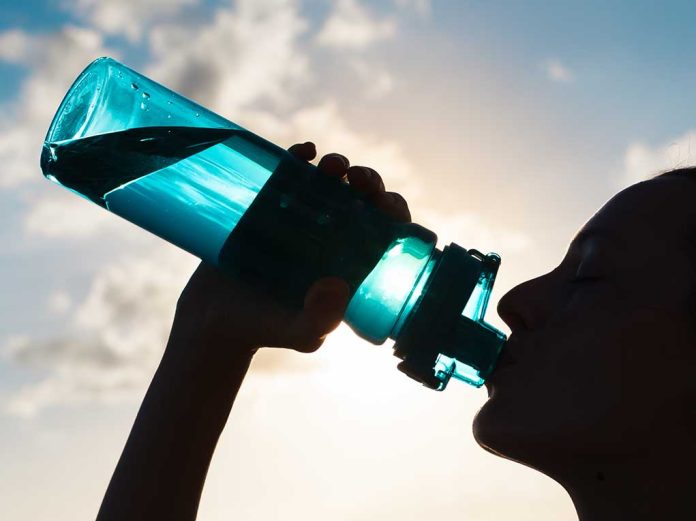
Millions of Americans unknowingly consume cancer-causing chemicals in their drinking water daily, potentially leading to over 100,000 cancer cases.
At a Glance
- A study by the Environmental Working Group links thousands of cancer cases to carcinogens in drinking water
- 22 carcinogens were identified, including arsenic, uranium, radium, and disinfectant byproducts
- Many community water systems meet legal standards, but contaminants at these levels can still harm health
- The EPA is investing $1 billion to address PFAS in drinking water
- Experts recommend filtering water at home to reduce exposure to contaminants
The Hidden Dangers in Your Tap Water
Recent investigations have uncovered a disturbing truth about the water flowing from our taps: it’s teeming with cancer-causing chemicals. While most community water systems meet legal standards, these standards are woefully outdated, leaving millions of Americans exposed to harmful contaminants.
The Environmental Working Group’s (EWG) study suggests that these carcinogens in our drinking water could be responsible for over 100,000 cancer cases.
The list of culprits is long and alarming: arsenic, uranium, radium, and disinfectant byproducts, to name a few. These aren’t just abstract chemical names; they’re real threats lurking in our glasses and our children’s sippy cups.
Groundwater sources, which many rural communities rely on, have higher concentrations of arsenic and radioactive materials, significantly increasing cancer risk. Meanwhile, surface water sources serve larger populations but aren’t without their own risks.
The "forever chemicals" known as PFAS are linked to cancer, reproductive problems, and weakened childhood immunity. Is your tap water affected?https://t.co/tM4kSLjguI
— EWG (@ewg) July 11, 2024
The Government’s Inadequate Response
While the Biden administration has recently taken steps to address some of these concerns, particularly regarding PFAS (per- and polyfluoroalkyl substances), their efforts fall short of what’s truly needed.
The EPA’s investment of $1 billion to address PFAS in drinking water is a drop in the bucket compared to the scale of the problem. It’s a classic case of too little, too late, leaving American citizens to fend for themselves against an invisible enemy.
“Drinking water contaminated with PFAS has plagued communities across this country for too long,” said EPA Administrator Michael S. Regan. “That is why President Biden has made tackling PFAS a top priority, investing historic resources to address these harmful chemicals and protect communities nationwide. Our PFAS Strategic Roadmap marshals the full breadth of EPA’s authority and resources to protect people from these harmful forever chemicals. Today, I am proud to finalize this critical piece of our Roadmap, and in doing so, save thousands of lives and help ensure our children grow up healthier.”
This statement, while promising, glosses over the decades of inaction that have led to this crisis. It’s a bandaid on a gaping wound, and American families deserve better.
The True Cost of Contamination
The health implications of this water crisis are staggering. Arsenic, strongly linked to cancers of the liver, lung, bladder, and kidney, is just one of the many contaminants found. Chlorine, used in water treatment, may significantly contribute to cancer risk, with its by-products associated with increased risks of bladder and rectal cancer. The presence of PFAS, known as “forever chemicals,” is linked not only to cancers but also to liver and heart impacts, and developmental damage in infants and children.
Dr. Olga Naidenko, EWG’s vice president for science investigations, states, “The vast majority of community water systems meet legal standards. Yet the latest research shows that contaminants present in the water at those concentrations … can still harm human health.” This stark reality underscores the urgent need for stricter regulations and more advanced purification methods.
Protecting Yourself and Your Family
In the face of government inaction, the burden of protection falls on individual citizens. The EWG recommends filtering water at home and offers a “Tap Water Database” tool for consumers to check their water quality. However, this do-it-yourself approach is a poor substitute for comprehensive, nationwide water safety standards.
It’s clear that the current system is failing to protect Americans from the dangers lurking in their tap water. The legal limits for contaminants have not been updated in decades, leaving citizens vulnerable to a host of health risks. While the government touts its efforts to address PFAS, it’s merely scratching the surface of a much larger problem.
As we wait for meaningful action from our leaders, it’s crucial to stay informed and take steps to protect ourselves and our families. Filter your water, stay updated on local water quality reports, and demand action from your representatives. The fight for clean, safe drinking water is far from over, and it’s a battle we can’t afford to lose.






















